Abstract
1. Recordings have been made of the activity in carotid body chemoreceptor afferent fibres and in the cervical sympathetic of the cat during passive movement of the hind limbs.
2. The chemoreceptor activity increases immediately the limbs are moved and is maintained at a raised level with preservation of the chemoreceptor rhythm fluctuations throughout. In some cases, the increase persists for a time after the movements are stopped.
3. This early change does not occur if the cervical sympathetic on the same side as the carotid body from which recordings are made is cut, nor does it occur if the femoral and sciatic nerves are cut.
4. The carotid artery oxygen tension (Pa, O2) increases early; in the majority of experiments, there was no significant change in end-tidal PCO2 although the minute volume of ventilation (V̇) increased by about 20% of control with passive movement of the hind limbs.
5. Passive movement of the hind limbs also causes an immediate rise in cervical sympathetic activity which is sustained, and which is abolished if the femoral and sciatic nerves are cut.
6. Electrical stimulation of the cervical sympathetic causes an increase in chemoreceptor afferent discharge.
7. Bilateral cervical sympathectomy causes the respiratory lag to increase from approximately 1 sec to some 20 sec and, when passive movements cease, the fall in V̇ is more sluggish than control.
8. These results are discussed in the light of the controversy regarding humoral and neurogenic causes for the increase in respiration in exercise.
Full text
PDF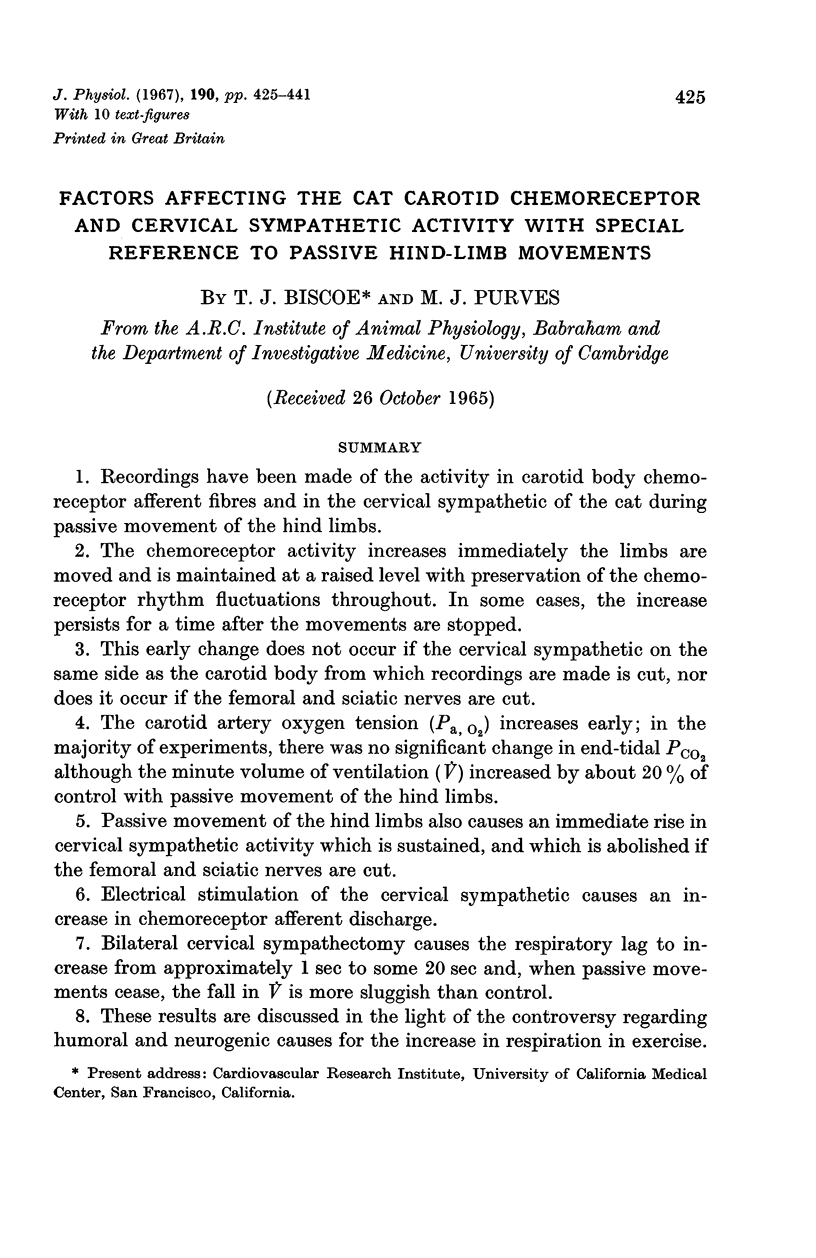
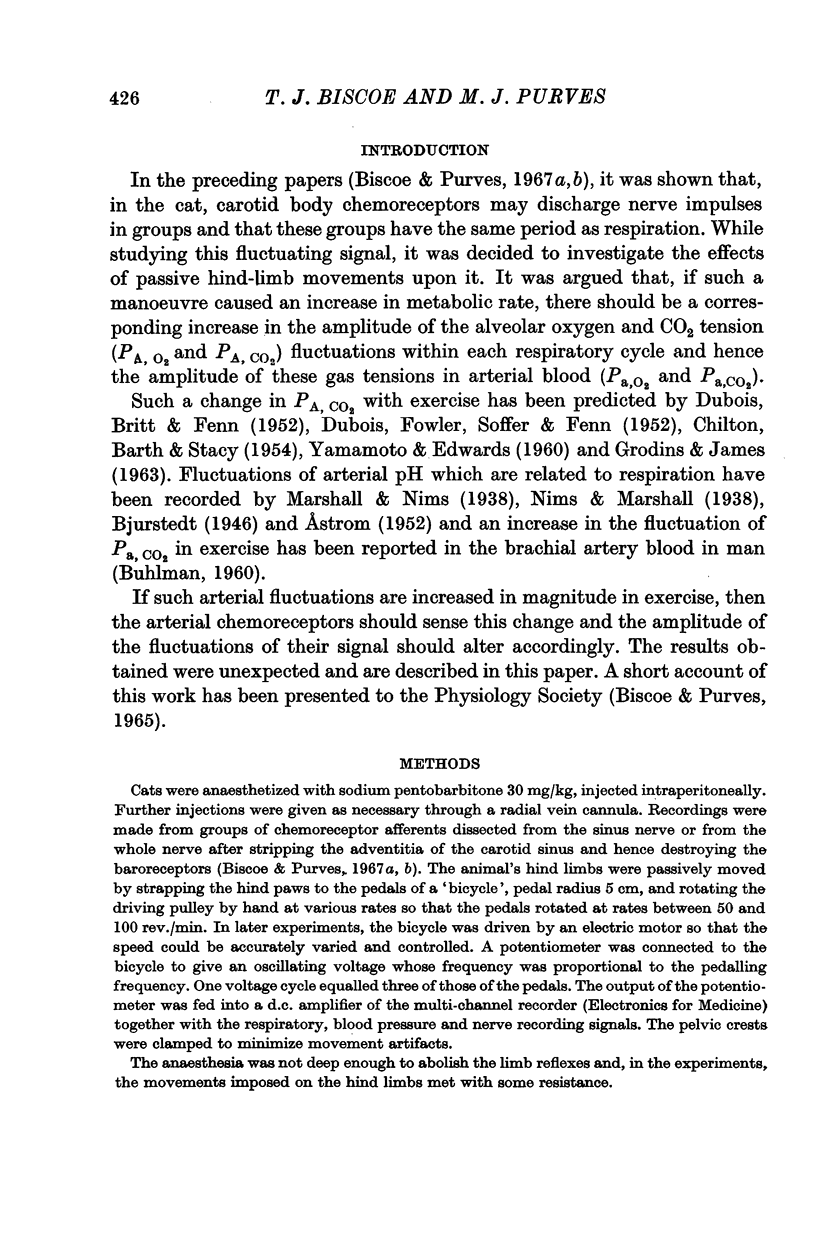
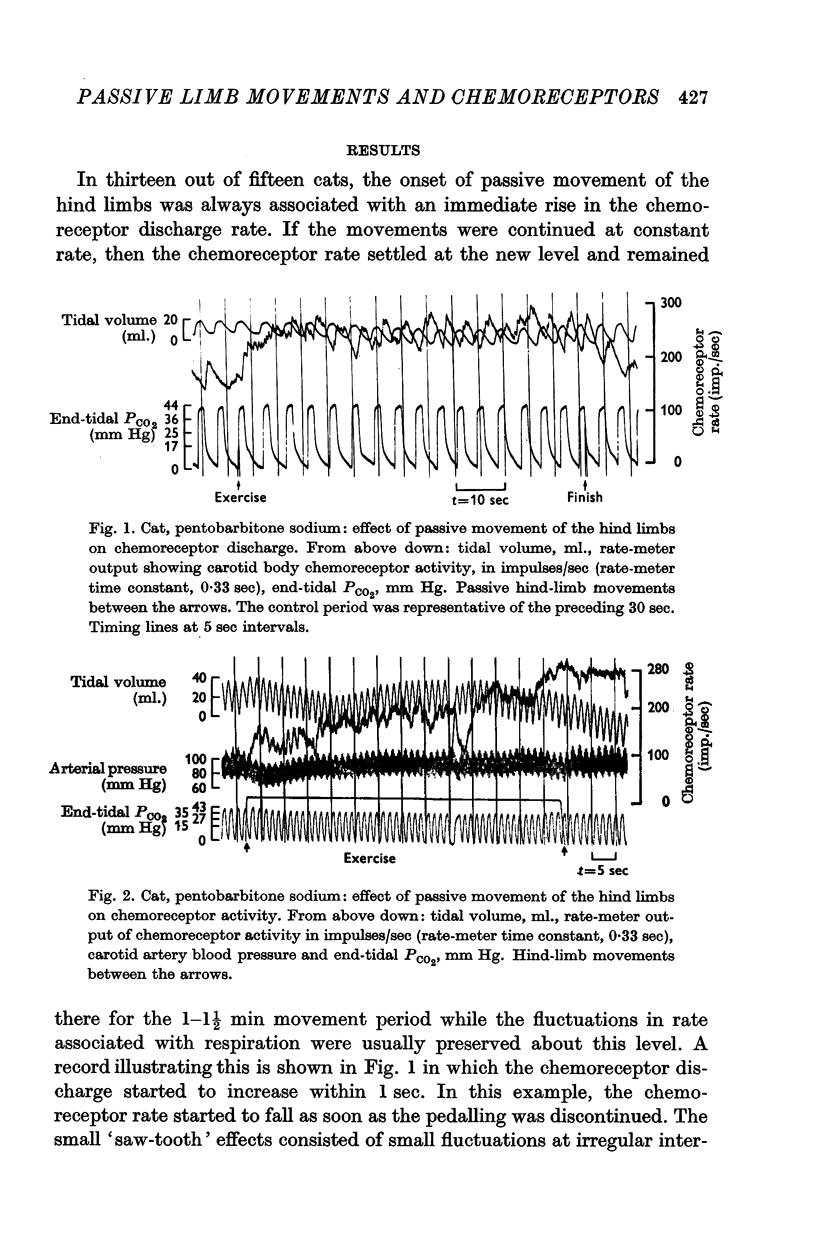
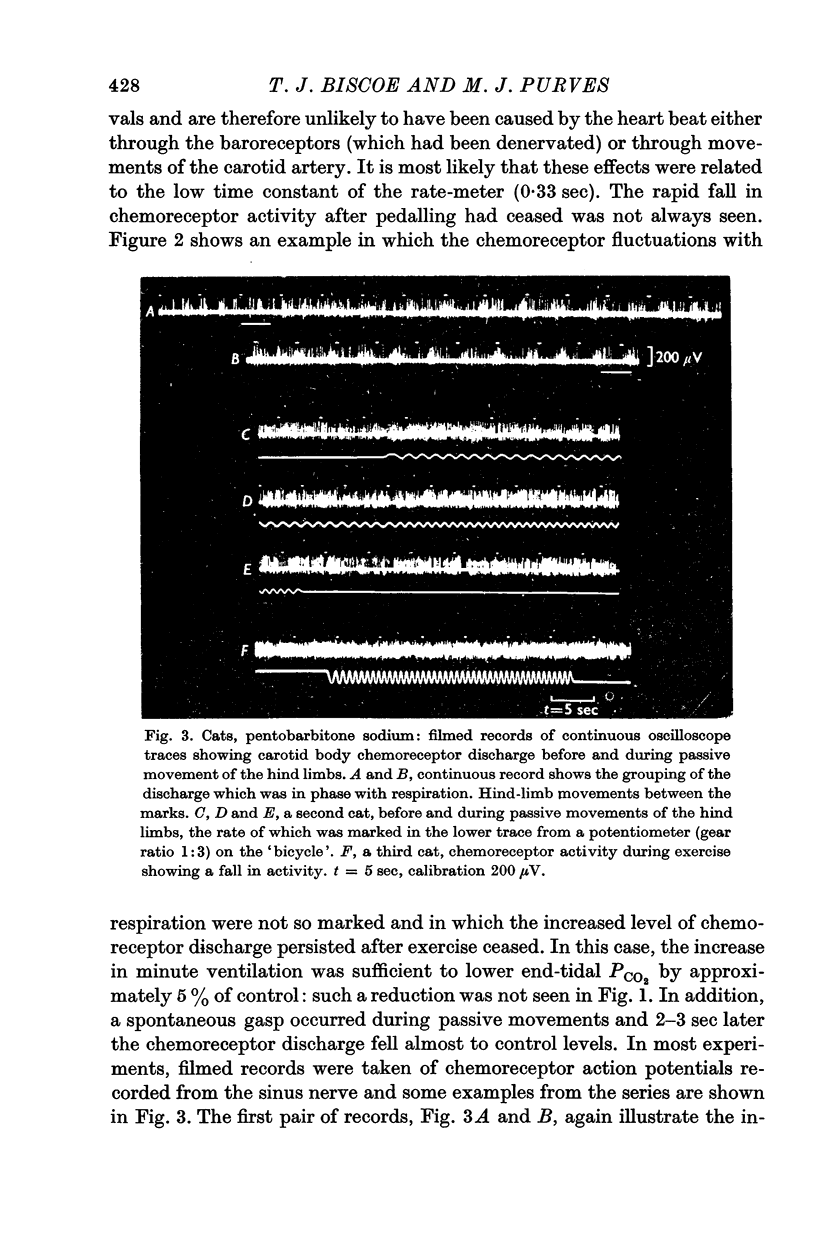

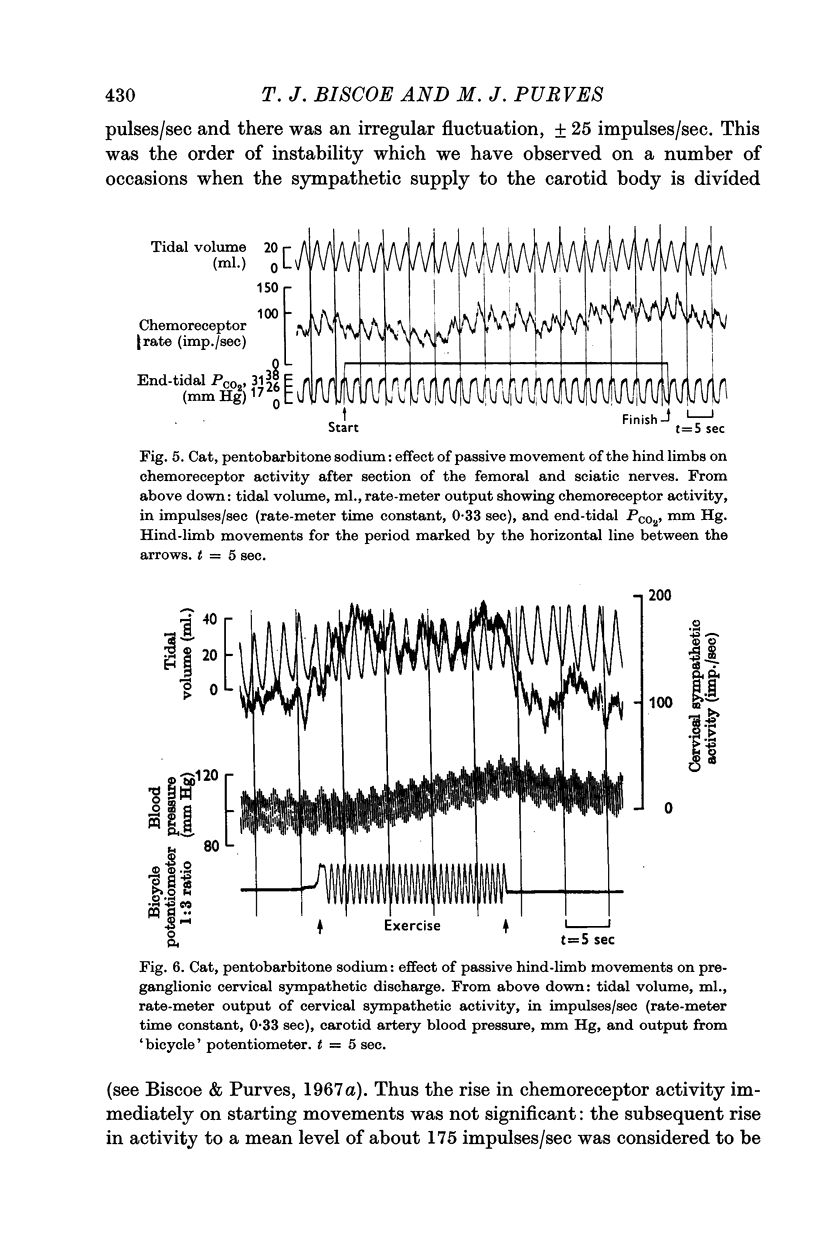
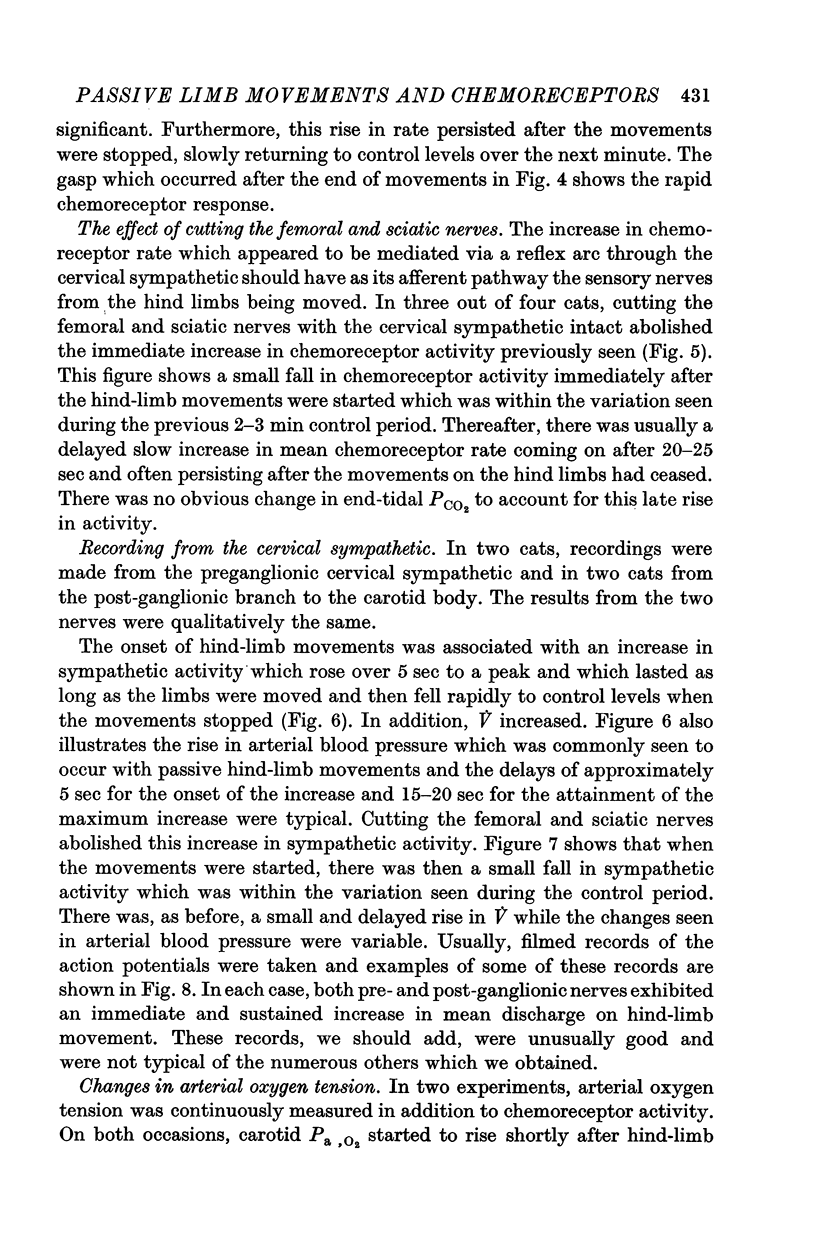


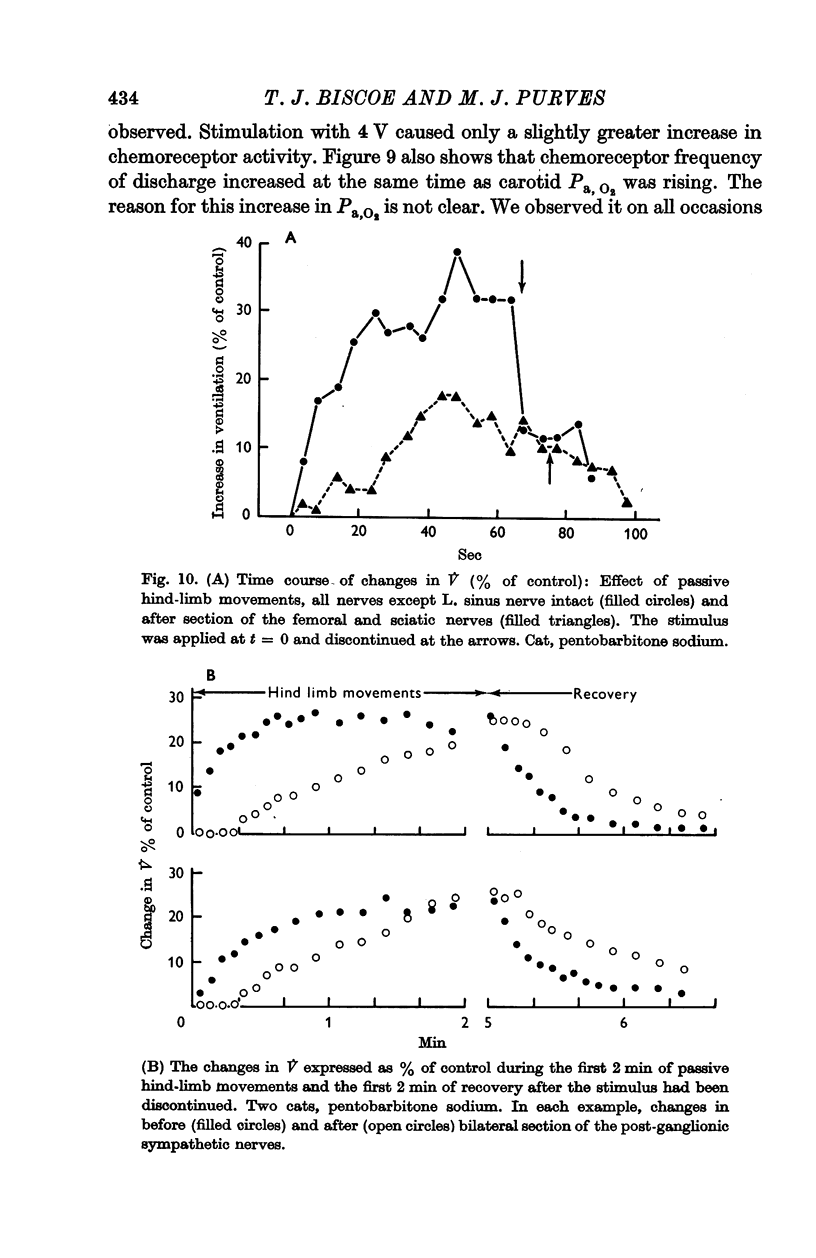
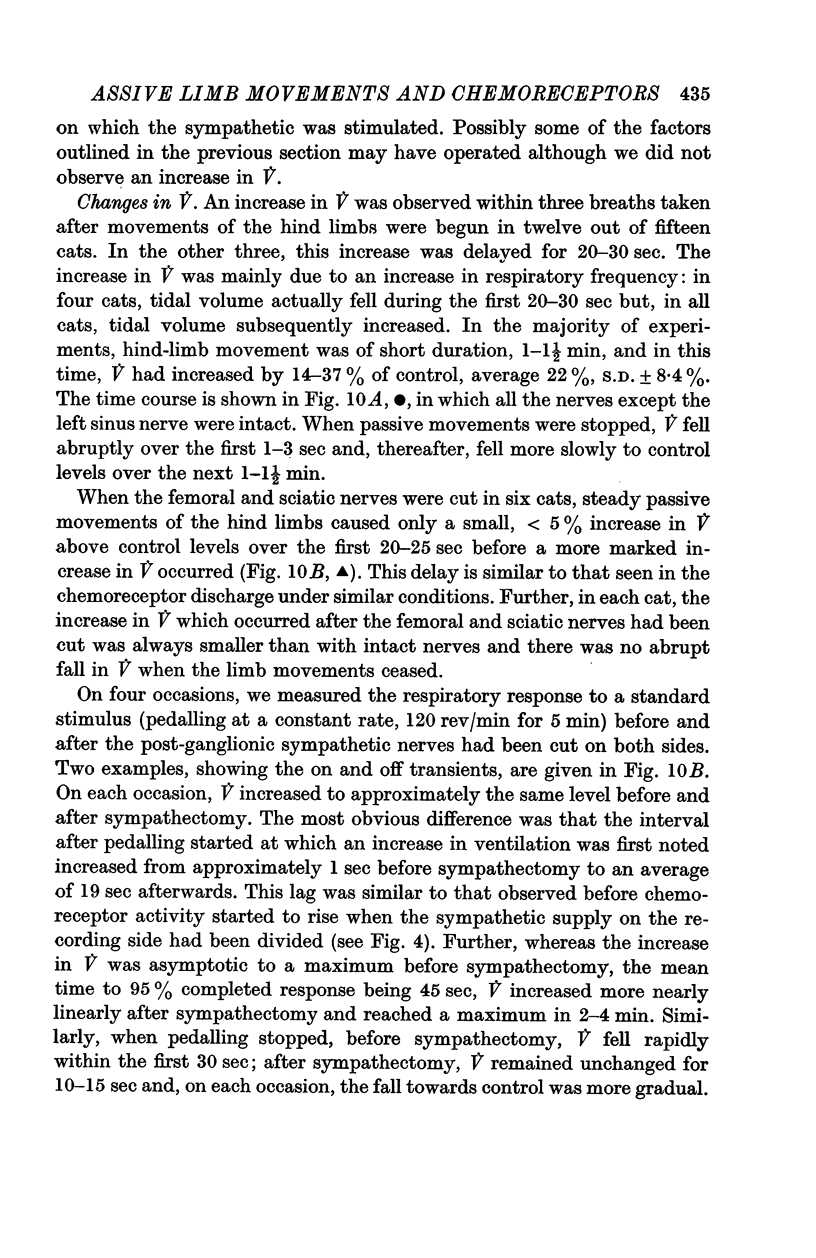

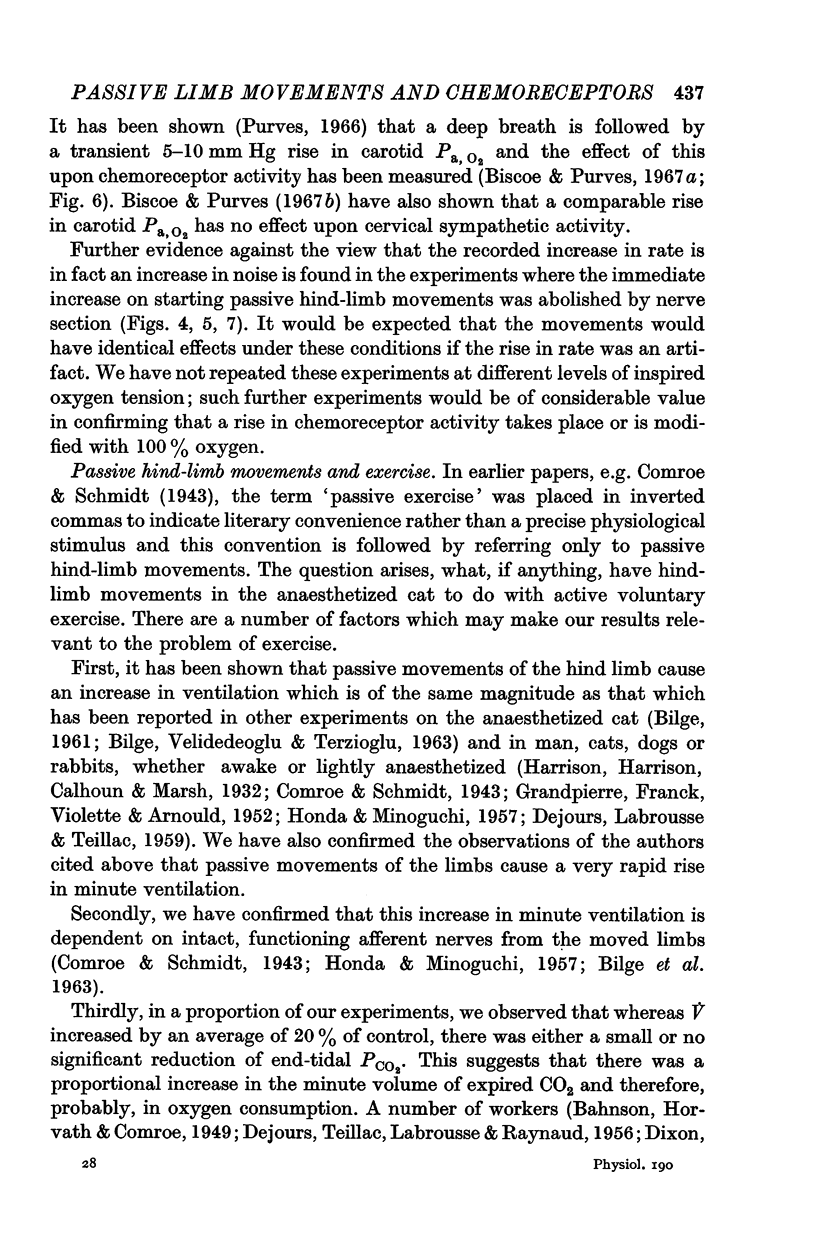
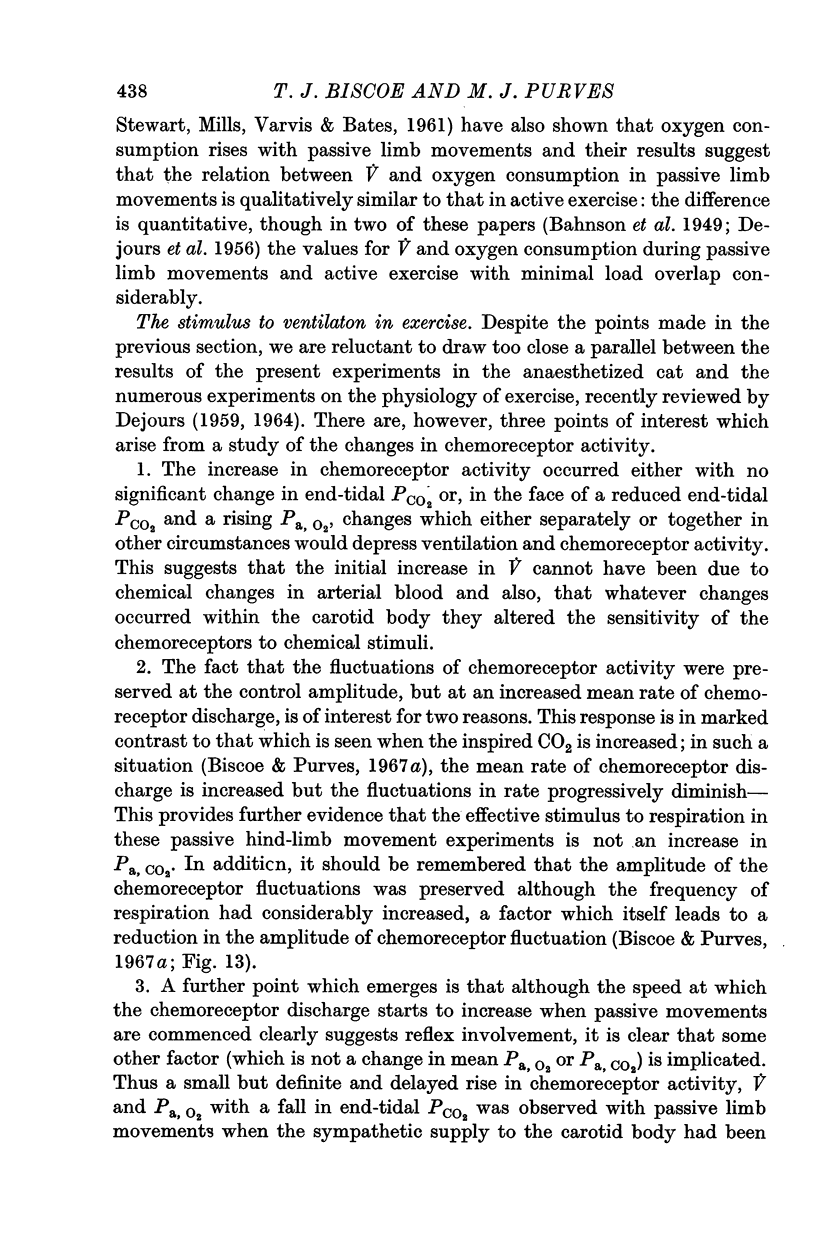
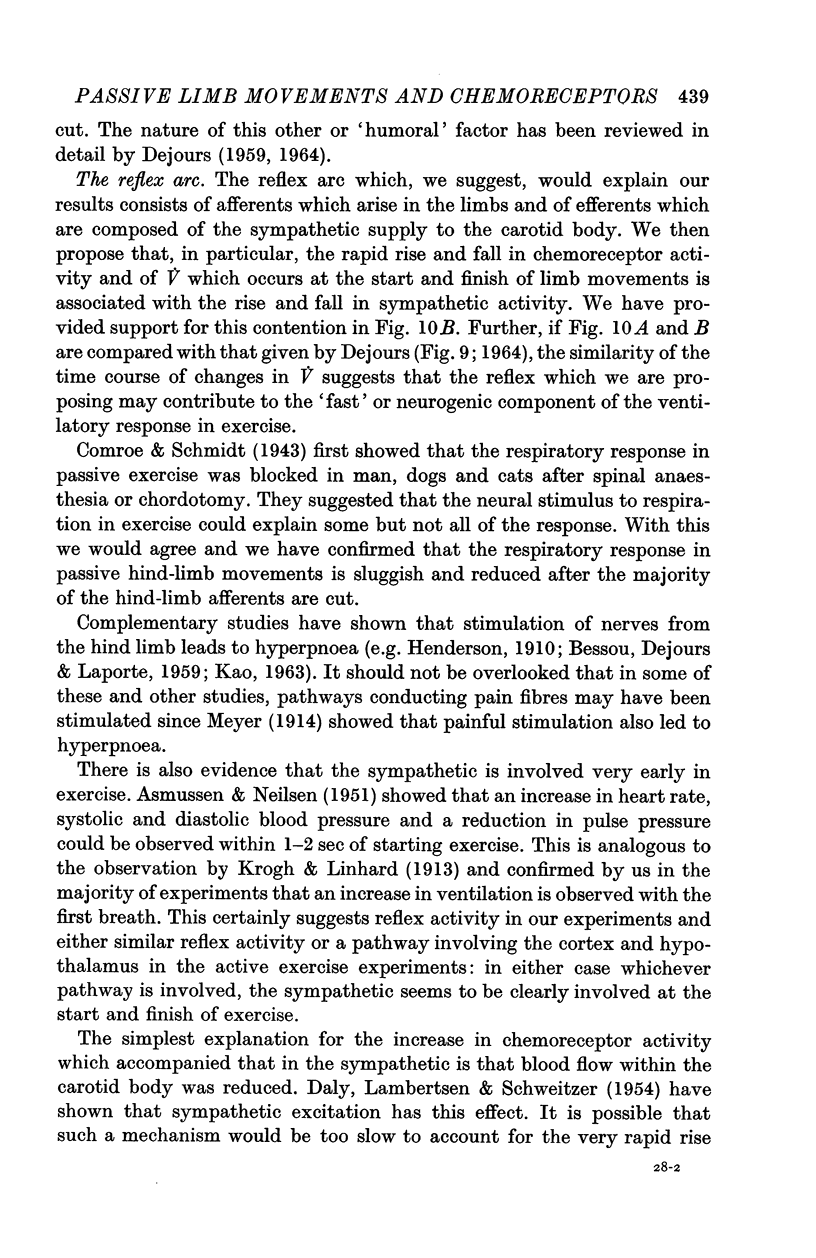

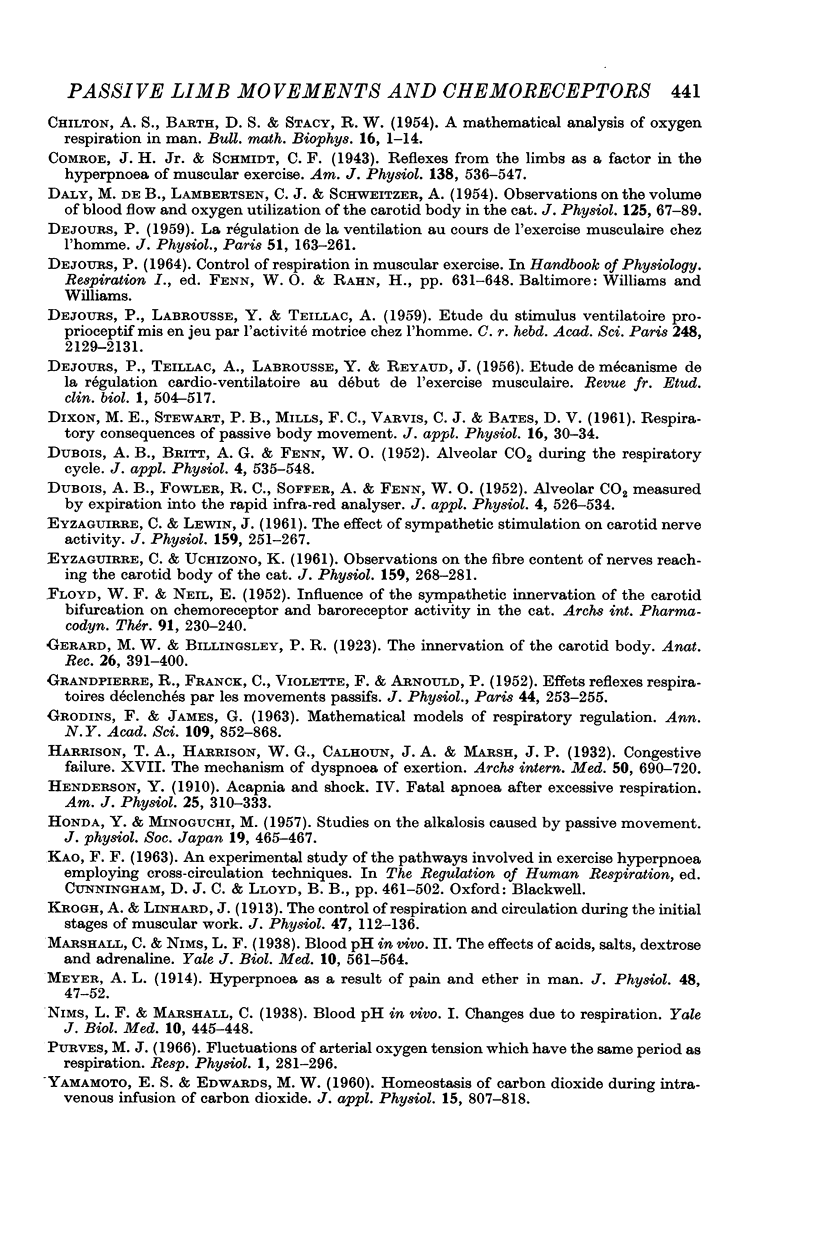
Selected References
These references are in PubMed. This may not be the complete list of references from this article.
- ASK-UPMARK E., HILLARP N. A. The fibre size in the carotid sinus nerve of the cat. Acta Anat (Basel) 1961;46:25–29. doi: 10.1159/000141766. [DOI] [PubMed] [Google Scholar]
- BESSOU P., DEJOURS P., LAPORTE Y. Effets ventilatoires réflexes de la stimulation de fibres afférentes de grand diamètre d'origine musculaire, chez le chat. C R Seances Soc Biol Fil. 1959;153(3):447–481. [PubMed] [Google Scholar]
- Biscoe T. J., Purves M. J. Observations on carotid body chemoreceptor activity and cervical sympathetic discharge in the cat. J Physiol. 1967 Jun;190(3):413–424. doi: 10.1113/jphysiol.1967.sp008218. [DOI] [PMC free article] [PubMed] [Google Scholar]
- Biscoe T. J., Purves M. J. Observations on the rhythmic variation in the cat carotid body chemoreceptor activity which has the same period as respiration. J Physiol. 1967 Jun;190(3):389–412. doi: 10.1113/jphysiol.1967.sp008217. [DOI] [PMC free article] [PubMed] [Google Scholar]
- Biscoe T. J., Silver A. The distribution of cholinesterases in the cat carotid body. J Physiol. 1966 Mar;183(2):501–512. doi: 10.1113/jphysiol.1966.sp007880. [DOI] [PMC free article] [PubMed] [Google Scholar]
- DE BURGH DALY M., LAMBERTSEN C. J., SCHWEITZER A. Observations on the volume of blood flow and oxygen utilization of the carotid body in the cat. J Physiol. 1954 Jul 28;125(1):67–89. doi: 10.1113/jphysiol.1954.sp005143. [DOI] [PMC free article] [PubMed] [Google Scholar]
- DEJOURS P., LABROUSSE Y., TEILLAC A. Etude du stimulus ventilatoire proprioceptif mis en jeu par l'activité motrice chez l'homme. C R Hebd Seances Acad Sci. 1959 Apr 6;248(14):2129–2131. [PubMed] [Google Scholar]
- DEJOURS P. La régulation de la ventilation au cours de l'exercice musculaire chez l'homme. J Physiol (Paris) 1959 Mar-Apr;51(2):163–261. [PubMed] [Google Scholar]
- DEJOURS P., TEILLAC A., LABROUSSE Y., RAYNAUD J. Etude du mécanisme de la régulation cardio-ventilatoire au début de l'exercice musculaire. Rev Fr Etud Clin Biol. 1956 May;1(5):504–517. [PubMed] [Google Scholar]
- DIXON M. E., STEWART P. B., MILLS F. C., VARVIS C. J., BATES D. V. Respiratory consequences of passive body movement. J Appl Physiol. 1961 Jan;16:30–34. doi: 10.1152/jappl.1961.16.1.30. [DOI] [PubMed] [Google Scholar]
- DUBOIS A. B., BRITT A. G., FENN W. O. Alveolar CO2 during the respiratory cycle. J Appl Physiol. 1952 Jan;4(7):535–548. doi: 10.1152/jappl.1952.4.7.535. [DOI] [PubMed] [Google Scholar]
- DUBOIS A. B., FOWLER R. C., SOFFER A., FENN W. O. Alveolar CO2 measured by expiration into the rapid infrared gas analyzer. J Appl Physiol. 1952 Jan;4(7):526–534. doi: 10.1152/jappl.1952.4.7.526. [DOI] [PubMed] [Google Scholar]
- EYZAGUIRRE C., LEWIN J. The effect of sympathetic stimulation on carotid nerve activity. J Physiol. 1961 Dec;159:251–267. doi: 10.1113/jphysiol.1961.sp006806. [DOI] [PMC free article] [PubMed] [Google Scholar]
- EYZAGUIRRE C., UCHIZONO K. Observations on the fibre content of nerves reaching the carotid body of the cat. J Physiol. 1961 Dec;159:268–281. doi: 10.1113/jphysiol.1961.sp006807. [DOI] [PMC free article] [PubMed] [Google Scholar]
- FLOYD W. F., NEIL E. The influence of the sympathetic innervation of the carotid bifurcation on chemoceptor and baroceptor activity in the cat. Arch Int Pharmacodyn Ther. 1952 Sep 1;91(1-2):230–239. [PubMed] [Google Scholar]
- GRANDPIERRE R., FRANCK C., VIOLETTE F., ARNOULD P. Effets réflexes respiratoires déclenchés par les mouvements passifs. J Physiol (Paris) 1952;44(2):253–255. [PubMed] [Google Scholar]
- GRODINS F. S., JAMES G. Mathematical models of respiratory regulation. Ann N Y Acad Sci. 1963 Jun 24;109:852–868. doi: 10.1111/j.1749-6632.1963.tb13510.x. [DOI] [PubMed] [Google Scholar]
- Krogh A., Lindhard J. The regulation of respiration and circulation during the initial stages of muscular work. J Physiol. 1913 Oct 17;47(1-2):112–136. doi: 10.1113/jphysiol.1913.sp001616. [DOI] [PMC free article] [PubMed] [Google Scholar]
- Meyer A. L. Hyperpnoea as a result of pain and ether in man. J Physiol. 1914 Mar 31;48(1):47–52. doi: 10.1113/jphysiol.1914.sp001647. [DOI] [PMC free article] [PubMed] [Google Scholar]
- Purves M. J. Fluctuations of arterial oxygen tension which have the same period as respiration. Respir Physiol. 1966;1(3):281–296. doi: 10.1016/0034-5687(66)90047-8. [DOI] [PubMed] [Google Scholar]
- YAMAMOTO W. S., EDWARDS M. W., Jr Homeostasis of carbon dioxide during intravenous infusion of carbon dioxide. J Appl Physiol. 1960 Sep;15:807–818. doi: 10.1152/jappl.1960.15.5.807. [DOI] [PubMed] [Google Scholar]


